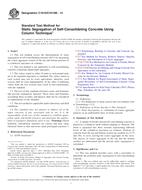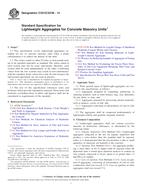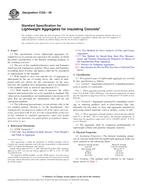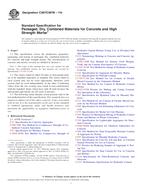We need your consent to use the individual data so that you can see information about your interests, among other things. Click "OK" to give your consent.
ASTM C1610/C1610M-14
Standard Test Method for Static Segregation of Self-Consolidating Concrete Using Column Technique
STANDARD published on 1.4.2014
The information about the standard:
Designation standards: ASTM C1610/C1610M-14
Note: WITHDRAWN
Publication date standards: 1.4.2014
SKU: NS-12013
The number of pages: 4
Approximate weight : 12 g (0.03 lbs)
Country: American technical standard
Category: Technical standards ASTM
The category - similar standards:
Annotation of standard text ASTM C1610/C1610M-14 :
Keywords:
coarse aggregate, self-consolidating concrete, stability, static segregation, ICS Number Code 91.100.30 (Concrete and concrete products)
Additional information
| Significance and Use | ||||||||||||||
|
5.1 This test method provides users with a procedure to determine the potential static segregation of self-consolidating concrete. Note 1: This test method may not be sufficiently rapid to
evaluate self-consolidating concrete mixtures in the field before
placement. Test Method C1712
provides a rapid method for assessing static segregation resistance
of self-consolidating concrete.
5.2 This test method shall be used to develop self-consolidating concrete mixtures with segregation not exceeding specified limits. Self-consolidating concrete is a fluid concrete that can be prone to segregation if not proportioned to be cohesive. A cohesive self-consolidating concrete is important for all applications but is especially critical for deep-section applications such as walls or columns. Therefore, the degree of segregation can indicate if a mixture is suitable for the application. Note 2: Some level of segregation is tolerable as long as the
desired strength and durability performance is achieved.
|
||||||||||||||
| 1. Scope | ||||||||||||||
|
1.1 This test method covers the determination of static segregation of self-consolidating concrete (SCC) by measuring the coarse aggregate content in the top and bottom portions of a cylindrical specimen (or column). 1.2 This test method is not applicable to self-consolidating concrete containing lightweight aggregate. 1.3 The values stated in either SI units or inch-pound units are to be regarded separately as standard. The values stated in each system may not be exact equivalents; therefore, each system shall be used independently of the other. Combining values from the two systems may result in non-conformance with the standard. 1.4 The text of this standard references notes and footnotes that provide explanatory material. These notes and footnotes (excluding those in tables and figures) shall not be considered as requirements of the standard. 1.5 This test method is applicable under laboratory and field conditions. 1.6 This standard does not purport to address all of the safety concerns, if any, associated with its use. It is the responsibility of the user of this standard to establish appropriate safety and health practices and determine the applicability of regulatory limitations prior to use. (Warning—Fresh hydraulic cementitious mixtures are caustic and may cause chemical burns to skin and tissue upon prolonged exposure.2) |
||||||||||||||
| 2. Referenced Documents | ||||||||||||||
|
Similar standards:
Historical
1.2.2013
Historical
1.1.2013
Historical
15.4.2014
Historical
15.4.2014
Historical
1.11.2009
Historical
15.12.2011
We recommend:
Technical standards updating
Do you want to make sure you use only the valid technical standards?
We can offer you a solution which will provide you a monthly overview concerning the updating of standards which you use.
Would you like to know more? Look at this page.



 ASTM C311/C311M-13..
ASTM C311/C311M-13.. ASTM C33/C33M-13..
ASTM C33/C33M-13.. ASTM C330/C330M-14..
ASTM C330/C330M-14.. ASTM C331/C331M-14..
ASTM C331/C331M-14.. ASTM C332-09
ASTM C332-09 ASTM C387/C387M-11b..
ASTM C387/C387M-11b..
 Cookies
Cookies
